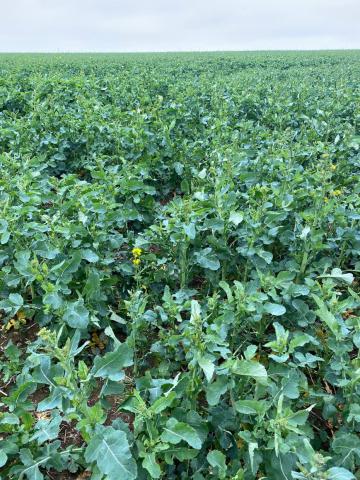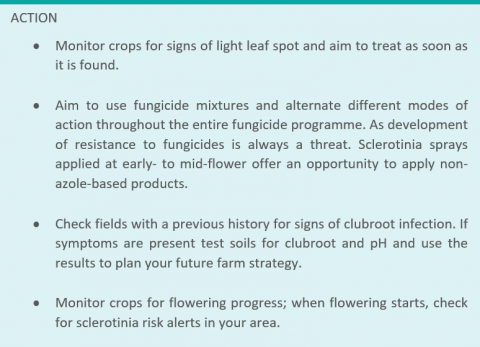Philip Walker

Reports of oilseed rape growth stages have varied across the country, with some crops still at the green bud stage but forward crops showing some very early flowering (Figure 1). The highest-risk time for sclerotinia infection in the crop is most often at about mid-flower when petal fall begins, but analysis of trial data from past years shows that infection during early-flower does occur if the weather is sufficiently mild and humid, and spore inoculum is present.
Figure 1. Signs of first flowers from an oilseed rape field crop near Cardigan, Wales. Source: ADAS.
AHDB have started their weather-based infection alerts for this season and these can be found via the link https://ahdb.org.uk/sclerotinia-infection-risk-alerts-for-oilseed-rape. This shows forecasts for the next 48 hours for temperature and humidity conditions which promote sclerotinia infection and are available for multiple locations across the UK. The thresholds for an alert are temperatures >7oC and humidity > 80%, for 23 or more consecutive hours. A simple indicator of likely alerts is the occurrence of mild nights when temperatures do not drop below 7oC. A few coastal areas in Scotland and the south of England are currently showing as high risk, and with the weather forecasted to remain mild next week the risk will depend on the flowering progress of oilseed rape crops and the presence of spore inoculum. Spore monitoring data on the AHDB website should be available for this season soon.
Monitoring the risk of infection risk will help decide on whether a fungicide treatment is justified at early flower. It may be that treatment can be delayed safely until mid-flower or even beyond, aiming to provide a window of protection long enough to avoid any need for a decision on a second treatment. Fungicides targeted at sclerotinia must be applied as protectants, ahead of infection, so it is worth considering spray strategies now.

